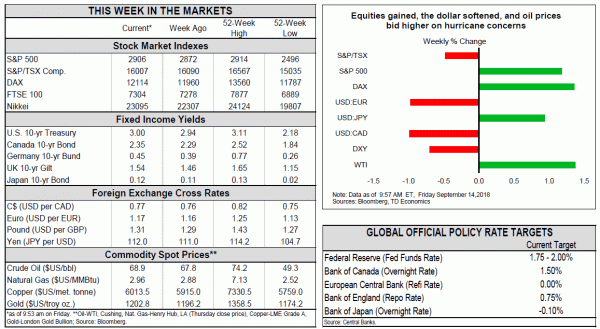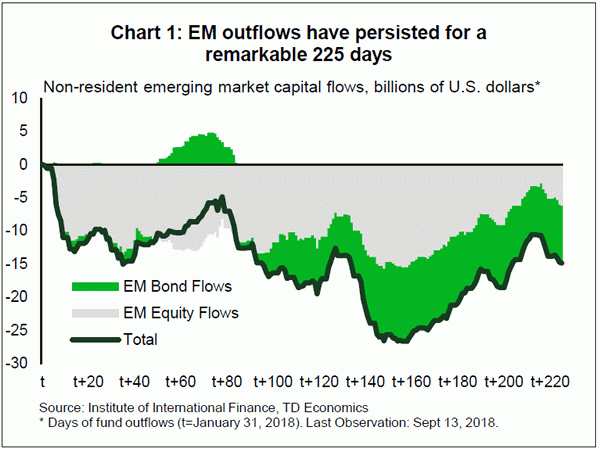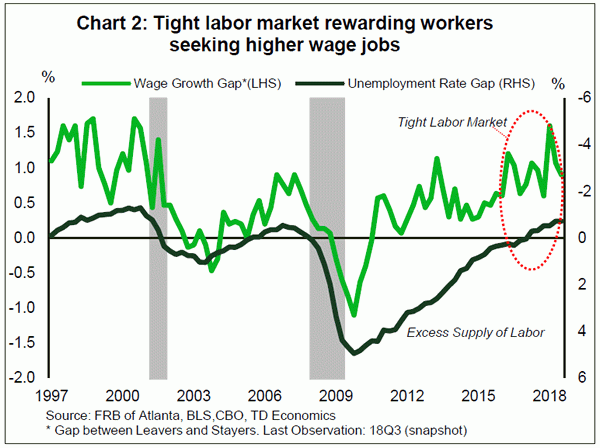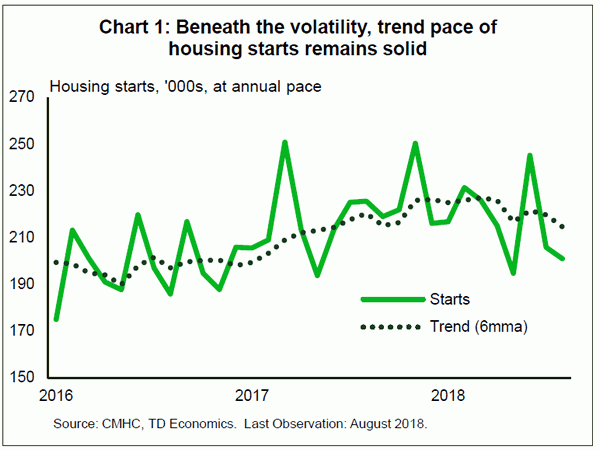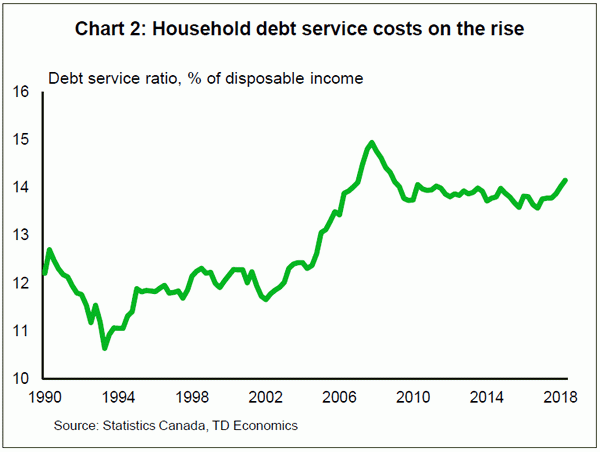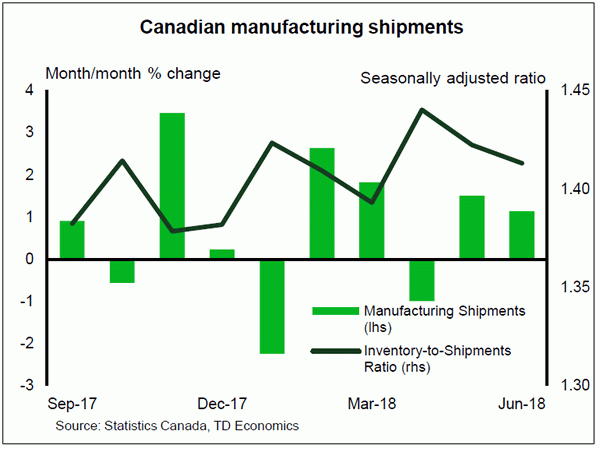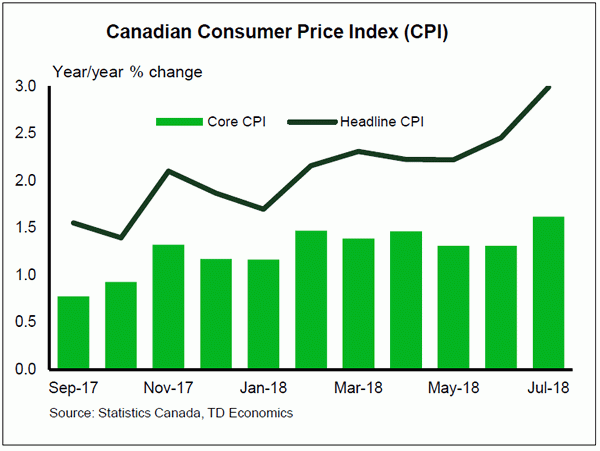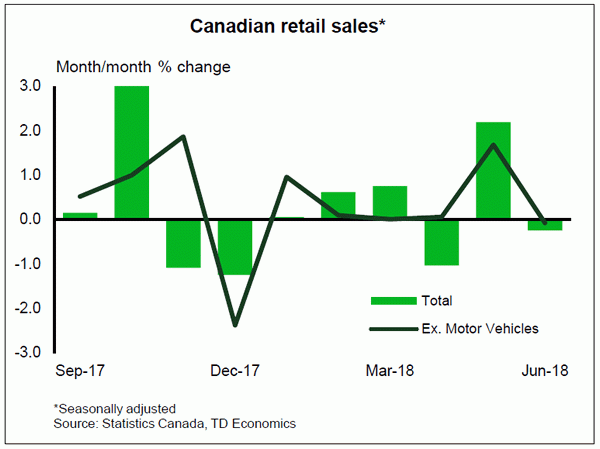The Weekly Bottom Line
U.S. Highlights
- Foreign central banks took center stage this week. The Central Bank of Turkey raised its policy rate to 24% from 17.75% in the hope of retaining and attracting new foreign capital.
- The ECB confirmed it will taper its asset purchases to €15 bn a month in October, with the program slated to end this December.
- On the domestic front, data this week confirmed that a robust economic expansion is underway. Labor market conditions are increasingly tilting in favor of workers.
Canadian Highlights
- Housing was in the spotlight this week. Starts declined slightly in August, but the underlying trend remains healthy.
- Slowing mortgage growth helped tame the rise in household-debt to income, but debt servicing costs continue to move higher in line with borrowing costs.
- Little progress was apparent in NAFTA discussions this week, with dairy remaining a key sticking point. Recent trade agreements suggest that Canada may be willing to provide some additional access to satisfy U.S. demands.
U.S. – Labor Market Tilting in Favor of Workers
U.S. equities managed to make gains this week, shrugging off turmoil in emerging markets and the threat of additional tariffs. Meanwhile, the selloff and pressure on emerging market currencies eased a bit, and the U.S. dollar softened a touch as foreign central bankers took center stage (Chart 1).
First up was the central bank of Turkey. It hiked its policy rate to 24% from 17.75% in the hope of retaining and attracting new foreign capital. The lira rallied, but still remains down 38% relative to the U.S. dollar since the end of January. Further rate hikes may yet be needed to help facilitate the rebalancing of Turkey’s economy, weaning it off from its reliance on foreign financing. But, these are likely to be resisted by President Erdogan, suggesting that Turkey may be unable to avoid the economic cost of high inflation and capital flight.
In neighboring Europe, both the Bank of England (BoE) and the European Central Bank (ECB) held monetary policy unchanged this week. With Brexit looming, the BoE is likely to hold interest rates at 0.75% until May. We anticipate a withdrawal agreement with the EU to be signed by year end, but there is still a small chance that the UK could make a chaotic exit from the EU next March. Such an event would prove detrimental to the UK economy, highlighted in recent discussions between Governor Carney and the UK government. Easy monetary policy would be unable to mitigate the economic damage from the negative supply shock that would result. Nor would it be able to offset the real income and spending drag resulting from a surge in inflation.
As largely anticipated, the ECB confirmed that it will taper its asset purchases to €15bn a month starting in October, with the program slated to end this December. Moreover, it signaled that, so long as risks to the economic outlook remain broadly in balance, interest rates may rise as early as September 2019. While the outlook for growth and inflation was revised down a touch, markets reacted positively to the ECB’s conviction that core inflation will near 2.0% by 2020, spurring a bid for the euro.
On the domestic front, data this week confirmed that a robust economic expansion is underway. Small businesses remained jubilant even as labor shortages and tariffs start to bite. The tightness of the labor market was underscored by July’s JOLTs data that recorded an uptick in the quits rate. Workers are increasingly being rewarded for quitting their current jobs for higher paying ones (Chart 2). Rising wages should continue to stoke prices pressures in the months ahead. That said, August inflation softened a touch to 2.7% (y/y), but we don’t view this as lasting given rising business cost pressures. Lastly, retail sales disappointed in August, but consumer spending is expected to remain healthy this quarter, buoyed by gains in wages and jobs. All told, the data this week suggest that this expansion has more room to run.
Canada – Rising Rates Eating Into Household Incomes
The major economic data this week was by and large housing focused. Housing starts disappointed expectations, dipping to a 201k annualized pace in August (from 205k in July). This tends to be a volatile series, and as it stands, there is little to be concerned about in the recent data. The modest slowing in the summer months comes after a robust June figure, and the trend remains comfortably above the 200k mark we associate with demographic fundamentals (Chart 1). Indeed, it remains the case that the trend is likely to drift back towards this anchor with time. With permit issuance still solid, there is little cause for alarm.
Statistics Canada also gave us an updated snapshot of Canadian household finances. The picture is pretty much what you’d expect. The closely watched measure of household debt to income rose to 169.1% (i.e. $1.69 owing for each dollar of disposable income). Reported on a non-seasonally adjusted basis, this ratio has risen in Q2 every year it has been published, but it is noteworthy that this year’s increase was the smallest since the year 2000. This moderation is likely a reflection of softer mortgage borrowing activity post B-20 implementation. With home sales already coming back late in the quarter, and further increases expected in the August data (watch for our commentary Monday), this respite may prove short-lived.
Of course, rising borrowing costs should act as a countervailing force as we move further through the year and into next. Elevated debt levels have left households more sensitive to rising interest rates than in the past. Evidence of this can already be seen in the household debt service ratio (Chart 2). The cost of servicing debt hit 14.2% of disposable income in Q2. This is a 0.4 percentage point increase over just 3 quarters, as the Bank of Canada raised its policy interest rate three times (75 basis points). July’s rate hike is not captured in this data, and with another likely to come in October, borrowing costs appear set to eat up a growing share of household income in coming years.
Finally, away from the data, there were mixed messages this week on the NAFTA front. Progress does appear to be continuing, but one clear point of contention is U.S. access to Canadian markets for dairy and other protected products. The good news is that there is recent precedent suggesting that Canada could yield some ground in this area, perhaps using it as a bargaining chip to achieve other goals. Both the TPP and CETA trade deals included at least some opening up of Canadian markets to foreign competition, indicating that there is scope for agreement as part of a broader deal. Of course, there also remains the issue of dispute resolution, another sticking point for Canadian negotiators. With two more weeks of negotiations remaining before any proposed text (with or without Canada) goes before Congress, there is still much ground to cover. Watch this space.
Canada: Upcoming Key Economic Releases
Canadian Manufacturing Sales – July
- Release Date: September 18, 2018
- Previous: 1.1%
- TD Forecast: 0.3%
- Consensus: 1.0%
Manufacturing sales are poised for a 0.3% increase in July. Durable goods should lead the advance on further gains in motor vehicle output, as foreshadowed by a pickup in exports, which should more than offset a modest drag in metals from steel and aluminum tariffs. Retaliatory tariffs were imposed on July 1st but will have little impact on manufacturing as a whole given that a large portion was directed towards goods for consumption. Energy may also act as a modest headwind on a pullback from the 15% increase in June though oil sands shutdowns are unlikely have a significant impact on downstream activity. Volumes should see a more modest gain (~0.1%) on higher factory prices which indicates little to no contribution to industry-level GDP growth in July.
Consumer Price Index – August
- Release Date: September 21, 2018
- Previous: 0.5% m/m, 3.0% y/y, index: 134.3
- TD Forecast: -0.4% m/m, 2.5% y/y, Index: 133.8
- Consensus: N/A
We expect CPI to come back down to earth to 2.5% after hitting 3.0% in July. The prior month’s spike was driven by upswings in airfares and to a less extent in travel tours and telephone services. We expect a significant correction in airfares in particular, as the recent methodological change is likely to introduce more volatility to the index. This should drive an overall 0.4% drop in prices on the month. Energy prices are also a net negative this month (led by lower gasoline prices) and we also see scope for a moderation in food prices. So far price impacts from Canada’s retaliatory tariffs have been negligible, but the categories to watch are food items, household appliances, personal care products and vehicles.
Our forecast implies exclusion-based core indexes (CPIX and CPIXFE) to slow this month, with the latter falling back to 2% or below. We expect the BoC core measures to remain near 2.0% on average. Looking ahead, despite the July upside we continue to expect a moderation toward 2.0% through year end.
Canadian Retail Sales – July
- Release Date: September 21, 2018
- Previous: -0.2%, ex auto: -0.1%
- TD Forecast: 0.1%, ex auto: 0.6%
- Consensus: N/A
Retail sales should post a 0.1% advance in July as a pullback in motor vehicle sales offsets a more upbeat 0.6% increase in the ex-autos measures. Unseasonably warm weather across most of the country will support gasoline sales along with higher prices at the pump, while alcohol sales should also benefit from the weather and World Cup festivities. Volumes should post a slight decline on higher consumer prices which will set up for a more modest pace of consumer spending in Q3, especially after a poor handoff from June. However, this should not come as a grave concern to policymakers at the BoC concerned with elevated levels of household debt.




